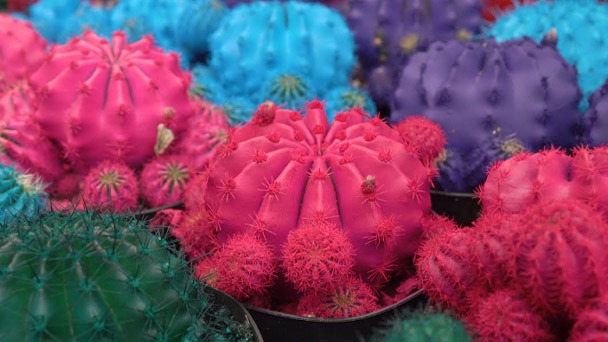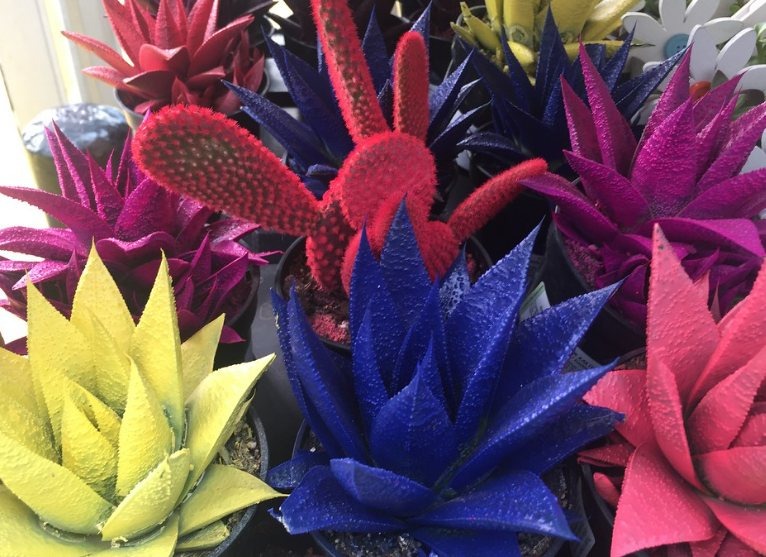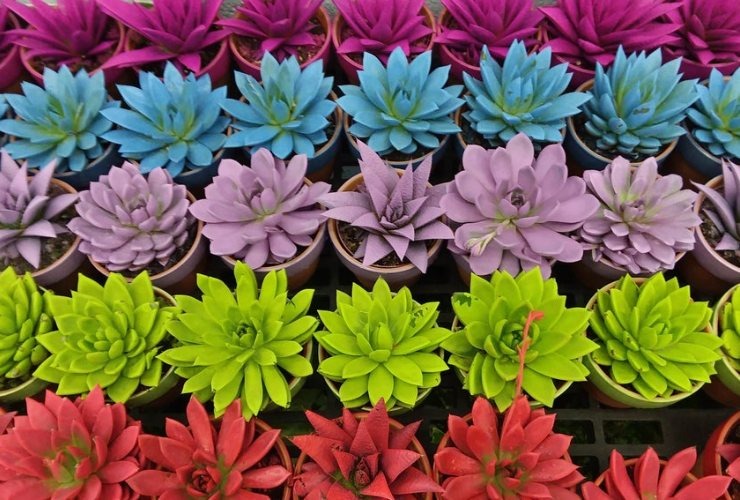What Is Kosmik Kaktus - How to Care for Painted Succulents
Written by Ivy
Jan 06 2023

Succulents called KosmiK KaKtus are either painted or dyed in vibrant colors to increase their beauty and allure. Echeveria, haworthia, and thimble cactus family succulents are frequently painted with acrylic paint before being sold for their aesthetic appeal and ease of maintenance.
In this article, we'll give you advice on how to safely remove the paint and give these painted succulents the attention they need.
What is Kosmik Kaktus?

Kosmik Kaktus is a succulent that has been painted or dyed with vivid colors to enhance its beauty. Although it is possible to paint these plants by hand, buying them already colored and ready to impress is easier. Additionally, there are virtually endless color combinations you can use to paint your Kosmik Kaktus.
Additionally, Kosmik Kaktus can be painted to make patterns, designs, shapes, or even words. If you want your plants to be a lighter color on their own, you can also dye them with plants of the same species as the Kosmik Kaktus.
How to Take Care of a Kosmik Kaktus?
In all honesty, there is no proper way to take care of a plant that was once perfectly healthy but has been sprayed or dipped in paint.
These painted succulents don't require repotting very frequently, similar to most cacti, as they do well in nutrient-poor soil and confined spaces.
The same guidelines apply to caring for these plants as for any other succulent. Maintaining them in a well-lit area and misting them with water once a week is sufficient.
They don't require pruning, are largely self-sufficient, and only need to be watered occasionally, about once a week.
Sometimes glue is used to glaze kosmik kaktus, and then glitter is added to give the plant a glitter effect.
By attaching fake flowers to the tops of some parodia magnifica, Mammillaria plumosa cacti, kosmik kaktus are made.
Yes, these are aesthetically pleasing, and to the untrained eye, one might mistakenly believe that they represent some innate beauty of nature when they don't.
Once, when I saw a beautifully decorated cactus with flowers and all, I nearly fell off my chair.
Thankfully, I noticed paint blotches of the same color to the side of the plant pot when I picked the plant up to take a closer look. It was fake!
I put it down right away because I was horrified. At that point, I began to wonder why it had happened.
How Long Will a Kosmik Kaktus Live?
Succulents and cacti are tough plants that can withstand the most hostile conditions.
The plant will live for a very long time before it starts to exhibit symptoms of stress or illness, even if it is covered in paint.
Succulents, however, go about this process a little bit differently. They have modified leaves that have prickly spines.
When there is little water loss due to evaporation and heat, the stomata only open at night to absorb carbon dioxide.
After taking in carbon dioxide, which is then stored until daylight, the stomata close.
Following the plant's absorption of sunlight during the day, photosynthesis starts to take place.
The spiny needles and the plant's base are typically not completely covered in paint, allowing it to continue to produce some food.
If the paint isn't removed, the plant will first experience stunted growth and eventually die because the limited photosynthesis cannot support the plant for the duration of its life.

How to Remove the Paint from a Succulent?
Succulents are painted with acrylic paint by dipping them in the solution while they are upside down.
Apart from dipping, succulents are also spray-painted with water-based paints and sometimes even glazed with glitter to produce a sparkle effect.
If no action is taken to remove the paint, it will continue to adhere to the plant for a very long time.
But fear not, they are easily removable using the methods listed below for various paint bases.
Removing Water Based Paint from Leaves
It is easy to remove water-based paint from a plant by soaking a cloth in water and wiping the leaves until all the paint is gone. You can use a cue tip in lieu of a clean cloth.
Qucik Steps
- Soak a clean cloth or rag in clean warm water
- Wring the cloth to get rid of the extra water.
- Apply a single-directional stroke to the leaf's surface to gently rub the paint away.
- Continue until all of the paint has been taken off the leaves.
Removing Oil Based Paint from Leaves
To completely remove the paint from Kosmik Kaktus, oil-based paints need organic solvents. Rubbish alcohol is the organic solvent that is least corrosive.
The paint is simply released from whatever it is attached to by breaking up the paint bonds. The paint can then be removed with a solitary one-directional stroke.
The steps for removal are similar to that of Water-based paint
- Soak a clean cloth or rag in rubbing alcohol
- Squeeze the cloth to remove the extra alcohol.
- Use a single-directional stroke to gently rub the paint off the leaf's surface.
- Continue until all of the paint has been taken off the leaves.
How Are Desert Gem Cacti Colored?
Normal cactus plants that have been artificially colored altered to resemble desert gem cacti.
These plants don't have the same hue as kosmik kaktus.
Contrary to popular belief, these plants aren't painted; rather, they're dyed with vibrant water-based pigments.
After some time, Kosmik Kaktus plant might start producing new growth that appears white.
If the plant had not been dyed, it actually would have that white appearance.
Although the dye improves Kosmik Kaktus's appearance to us, it has no positive effects on the plant itself.

How to Paint a Kosmik Kaktus?
The ideal plant to spruce up your house or place of business is a succulent. However, did you know that you can also paint Kosmik Kaktus? Here are some quick steps on how to paint a succulent and make it look just as pretty as a naturally colored one:
- Gather your materials: a paintbrush (preferably one for small spaces), some clear top coat spray, and three or four different acrylic paint colors.
- The succulent should first have the base coat painted on all sides. To prevent you from being able to tell what color is underneath, use an even coat that is entirely opaque.
- Choose your colors and get Kosmik Kaktus ready in tiny bowls while you wait for the base coat to dry. Use different brushes for each color if you're using more than two, we promise. Though you can experiment, we've found that keeping paints separate produces the best results.
- Start painting your design once the base coat has dried. You can use any pattern or color scheme you like, but if you don't want your design to be permanent, remember to leave room for the topcoat.
- Before applying your topcoat spray, give the surface about 30 minutes to dry. Otherwise, you run the risk of smudging all of your hard work.
- Before showcasing your new creation, wait another 30 minutes for it to dry after applying a few layers until you achieve a nice shine.
You now possess a stunning, long-lasting painted succulent. Your new creation will last for a while if you take good care of it. There is no end to the kinds of designs you can make with the numerous paint colors that are currently available. Decide on your favorite colors and start painting.
Why Should You Not Paint Succulents?
Succulents shouldn't be painted with paint unless it serves a specific purpose. One of the most well-liked plants in the world is succulent, and to make them more appealing, they are frequently painted in vivid hues.
Succulents can become sickly and live shorter lives as a result of painting, so this practice is not without risk. Try to stick with plants that are grown in soil unless you have gardening experience or unless you want your crisp flowers to look like they were plucked straight out of a Tim Burton movie.
Be aware that dying succulents different colors has drawbacks as well if you're interested in doing so. The painting will start to deteriorate after a few weeks if the plant cannot handle the color.
The Bottom Line
Kosmik Kaktus has been used by gardeners and designers as an aesthetically pleasing addition to any outdoor setting, but it can also be helpful in the home when looking for something low-maintenance and vibrant.
The best thing about these plants is that they don't need much attention; they're ideal if you want a simple plant to grow indoors or out.
If you have Kosmik Kaktus as a houseplant or an outdoor specimen, it's important to wear protective gear, especially when pruning, as the paint used to color the plant can be toxic if ingested.
Latest Updated
- Benefits of Bugleweed - 7 Science-backed Health Benefits
- Bugleweed Dangers & Side Effects - Is It Poisonous?
- How to Plant Evergreen Trees - What You Should Know
- When to Plant Evergreens - Grow Guide for Evergreen Trees
- 12 Wonderful Evergreen Shrubs for Your Garden
- 12 Popular Evergreen Plants with Pictures for Beginners
- When And How To Prune A Lilac Bush Like a Pro
- How to Grow & Care for Lilac Vine (Hardenbergia Violacea)
- Japanese Lilac Tree (Syringa Reticulata) Care & Propagation Guide
- Shumard Oak Pros and Cons - What to Know
Popular Articles
- Winter maintenance of Antirrhinum Majus
- How to Grow Terminalia Mantaly Tree
- How to Grow and Care for Crossostephium Chinense
- How to grow Antirrhinum Majus in spring
- Peristeria Elata (Dove Orchid) Profile: Info & Care Guide
- Underwatered Snake Plant (Sansevieria Trifasciata) - Signs And How To Fix
- How to Care for Brazilian Jasmine Plant (Mandevilla Sanderi)
- How to Grow & Care for Graptopetalum Purple Delight in Summer
- Rosa Chinensis (China Rose): Plant Growing & Care Tips
- How to Care for Baby Sun Rose (Aptenia Cordifolia)